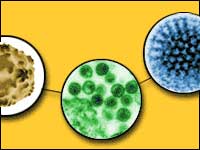Diverse Viruses Show Signs of Common Ancestry

The viruses that cause diseases as varied as AIDS, hepatitis and West Nile Virus may actually have more in common than was previously thought, new research reveals. According to a study that will appear in the March issue of the journal Molecular Cell, three major groups of viruses use similar mechanisms to replicate their genetic information after they have infiltrated the cells of a host.
There are six broad classes of viruses, each thought to represent a major evolutionary lineage. Michael Schwartz, Jianbo Chen and colleagues at the University of Wisconsin, Madison studied the viral replication process and found that key features of the procedure run parallel in three of the six groups. Positive-strand RNA viruses, reverse transcribing viruses and double-stranded RNA viruses, they report, use similar basic mechanisms to replicate, despite differences in how the viruses move between host cells. The scientists determined that the three groups, which together comprise more than half of the world’s known virus families, all replicate their genome using messenger RNA and generate spherules to sequester them within newly infected cells. “This new virus-induced compartment, in which the virus genome is reserved and copied, shows surprising similarities across these different virus groups,” notes study co-author Paul Ahlquist of the Howard Hughes Medical Institute at the University of Wisconsin, Madison.
Such fundamental similarities in replication among the viruses suggest they may have common evolutionary origins, the authors write. “These results have added considerably to our understanding of these viruses, and any new basic knowledge is useful in control,” Ahlquist says. “If you know the machinery, you know where to throw the wrench to mess it up.”
Media Contact
All latest news from the category: Life Sciences and Chemistry
Articles and reports from the Life Sciences and chemistry area deal with applied and basic research into modern biology, chemistry and human medicine.
Valuable information can be found on a range of life sciences fields including bacteriology, biochemistry, bionics, bioinformatics, biophysics, biotechnology, genetics, geobotany, human biology, marine biology, microbiology, molecular biology, cellular biology, zoology, bioinorganic chemistry, microchemistry and environmental chemistry.
Newest articles

Bringing Quantum Mechanics to Life
New ISTA assistant professor Julian Léonard makes abstract quantum properties visible. From the realm of the abstract to the tangible, the new assistant professor at the Institute of Science and…

Who moved my atom?
Researchers at the Technion Faculty of Physics have demonstrated controlled transfer of atoms using coherent tunneling between “optical tweezers”. An experimental setup built at the Technion Faculty of Physics demonstrates…

A milestone for reproductive medicine
Producing viable eggs from undeveloped oocytes through In vitro technology. Researchers successfully produce viable, embryo-forming egg cells from underdeveloped oocytes extracted from ovarian follicles. Mature egg cells, or oocytes, are…



